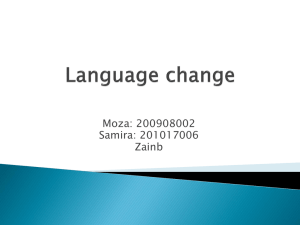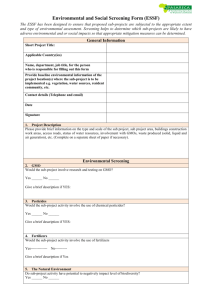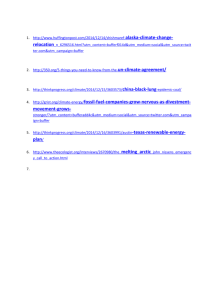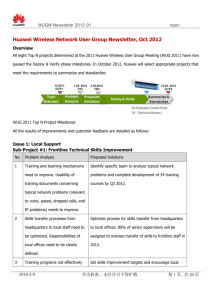13 Presentation by Indonesia
advertisement
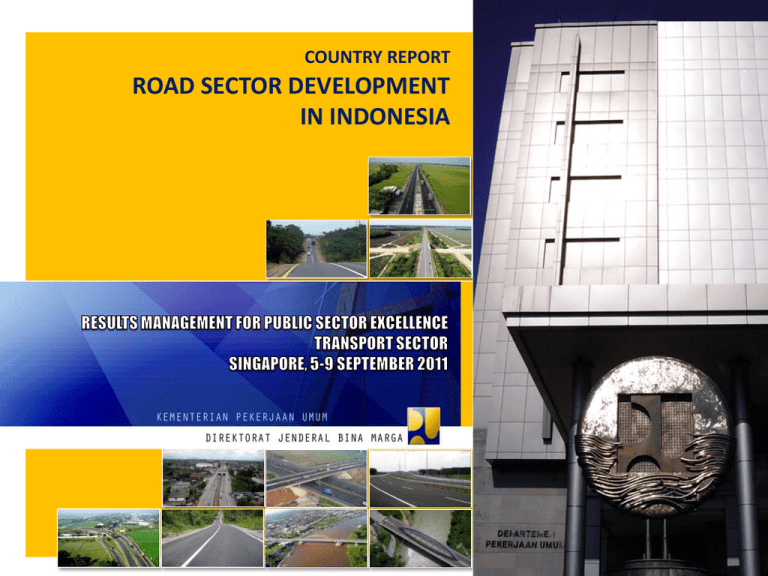
COUNTRY REPORT ROAD SECTOR DEVELOPMENT IN INDONESIA DIRECTORATE GENERAL OF HIGHWAYS STRATEGIC PLAN 2010-2014 STRATEGIC PLAN DIRECTORATE GENERAL OF HIGHWAYS 2010-2014 Vision • The realization of a reliable, integrated and sustainable national road network to support economic growth and social welfare. • Realizing sustainable national road network of sufficient mobility, accessibility and safety, to serve national and regional activity centres as well as national strategic areas Mission • Realizing inter-urban national freeway network and in urban areas with intense logistical movement connecting and serving major national economic activity centres • Facilitating local governments capacity in sustainable road management to provide mobility, accessibility and safety 3 CONCEPT OF ROAD NETWORK FORMULATION • RTRWN • UU No. 24/ 1982 PP No. 47 TH. 1997 ttg RTRWN • ENVIRONMENT Law /Regulation on Road : • UU No. 38 TH. 2004 • PP No. 34 TH. 2006 • PP No. 15 TH. 2005 (on Toll Road) UU, PP ttg Lalu Lintas : • UU No. 14 TH. 1992 • UU No. 22 TH. 2009 • PP. No. 43 TH. 1993 PRIMARY ARTERIAL PRIMARY SYSTEM (NATIONAL) PRIMARY COLLECTOR PRIMARY LOCAL JAR. TRANSP. NAS./SISTRANAS (Land Transport, Road sub sector) (MID TERM & LONG TERM) SECONDARY ARTERIAL • GROWTH • EQUALITY MID TERM AND LONG TERM POLICY AND STRATEGY OF ROAD MANAGEMENT SECONDARY SYSTEM (URBAN) SECONDARY COLLECTOR SECONDARY LOCAL 4 LOGISTIC SYSTEM • The increasing competition at global level impose every country and business players to improve effectiveness and efficiency of logistic system • The performance of Indonesia’s logistic sector is not yet optimum due to high logistic cost and low service level 5 LOGISTIC PERFORMANCE OF INDONESIA AMONG ASEAN+6 6 NATIONAL CONNECTIVITY FRAMEWORK Locally Integrated, Globally Connected Regional Develop ment Domestic Connectivity ICT - Intra island Sistranas - Inter island - Internasional Sislognas 7 NATIONAL CONNECTIVITY FRAMEWORK (Continued) Integration of Sislognas, Sistranas (multimodal transport, master plan of seaport, airport, road, and railway) and regional development plan This framework considers the natural condition, geography and demography Ports Roads Railways Airports Multimodal 8 VISION OF CONNECTIVITY FRAMEWORK: LOCALLY INTEGRATED, GLOBALLY CONNECTED 3 Levels of Connectivty City Town Island Town Asia City Indonesia International Gateway Town Town City Island Town Europe City Town Town Island Town America City Among Growth Poles Within Growth Poles (sub-regions) (urban) Intra-island LOCAL Connectivity Inter-island NATIONAL Connectivity International GLOBAL Connectivity 9 NATIONAL DEVELOPMENT CORRIDOR BASED ON NATIONAL SPATIAL PLAN (RTRWN) Benggala Gulf, Mediteran, Indian Ocean (Middle East, Europe) South China Sea (Japan, Korea, Philippine) South China Sea (Hongkong, China, Taiwan) Lhokseumawe Pacific Ocean (Japan, Korea, USA, Canada) BANDAR SRI BEGAWAN KUALA LUMPUR Simanggaris Mebidang Entikong Dumai Bontang SINGAPORE Pekanbaru Jambi Bontang Pontianak Batam Gorontalo Pacific Ocean (USA, Canada, Latin America) Ternate Manado Samarinda Sorong Palu Biak Palangkaraya Pangkalan Bun Padang Palembang Bengkulu Bandar Lampung Jayapura Ambon Kendari Banjarmasin Makasar Bau-bau Serang Jakarta Bandung Semarang Yogyakarta Surabaya Malang DenpasarMataram Indian Ocean (Africa, Australia) Merauke DILLI Kupang Indian Ocean (Australia, New Zealand) Major Island International Seafare Route ZEE Border National Activity Centres Regional Activity Centres Sumber: Ditjen Penataan Ruang Nasional, 2009. National/Global Strategic Development Axis National Strategic Development Axis Sub-Regional Economic Cooperation Production Area Ocean Production Area 10 DEVELOPMENT OF 6 PRIORITY ECONOMIC CORRIDOR 11 NATIONAL ROAD ASSET NATIONAL ROAD Length of national road according to Ministerial Decree No. 631/KPTS/M/2009 dated December 31st, 2009 is 38.569,83 km located on 33 provinces. TOLL ROAD Length of toll road according to Ministerial Decree No. 631/KPTS/M/2009 dated December 31st 2009 is 757,47 km located on : Sumatera Island 42,70 Km Java Island 697,12 Km Sulawesi Island 17,65 Km 12 RELATION BETWEEN ROAD CLASIFICATION AND MANAGEMENT AUTHORITY NETWORK SYSTEM CLASIFICATION/FUNCTION CLASIFICATION/ MANAGEMENT ADMINISTRATION AUTHORITY TOLL ROAD MINISTER (PW) NATIONAL ROAD MINISTER (PW) PROVINCIAL ROAD PROVINCIAL GOVERNMENT DISTRICT ROAD LOCAL/NEIGBORHOOD ROAD DISTRICT GOVERNMENT SECONDARY ARTERIAL COLLECTOR LOCAL NEIGHBORHOOD SYSTEM URBAN ROAD MUNICIPAL GOVERNMENT ARTERIAL ROAD K-1 PRIMARY SYSTEM COLLECTOR ROAD K-2 K-3 K-4 NOTE : K1 = CONNECTING AMONG PROVINCIAL CAPITALS K2 = CONNECTING PROVINCIAL CAPITAL WITH DISTRICT CAPITAL/CITY K3 = CONNECTING AMONG DISTRICT CAPITALS OR CITIES K4 = CONNECTING DISTRICT CAPITAL WITH SUB-DISTRICT 13 DG OF HIGHWAYS OBJECTIVE 2010 - 2014 1. Percentage of road network in a stable condition increase up to 94%; 2. Length of road to be expanded in terms of capacity about 19.370 km or increase of 13.000 lane-km; 3. Facilitation of regional/local road development to achieve 60% of stable condition. 14 MEASURES FOR PERFORMANCE MANAGEMENT PERFORMANCE STATEMENT Annual performance plan is suited with budget availability according to budgeting process documents. Performance statement is a quantitative government’s commitment for one year period. Performance statement is agreed among program implementator and the superior (performance agreement) at each government institution. 16 CYCLE OF PLANNING PROGRAMMING & BUDGETING Nota Keuangan (NK) INDICATIVE CEILING Meeting With Parliament Satuan-3 (RKA-KL) TEMPORARY CEILING MUSRENBANG Committed Project DEFINITIVE CEILING TRILATERAL MEETING Road Condition Year-N IRMS Program Recommendation Condition Survey KONREG Implementation RKP/RENJA SAPSK/DIPA 17 STRATEGIC FRAMEWORK OF ROAD MANAGEMENT IRMS ROAD PRESERVATION UNCONST RAINED BUDGET NEEDS KONREG CAPACITY EXPANSION FS REGIONAL DEVELOPMENT 18 CONCEPT OF ROAD PRESERVATION Road deterioration curve with maintenance Periodic Maintenance Structural Improvement Service Capacity Po Pt IDEAL PATH Deterioration curve condition without maintenance CRITICAL LIMIT Routine Maintenance Routine Maintenance Routine Maintenance Age (year) 19 TYPES OF ROAD ACTIVITY 1. ROUTINE MAINTENANCE Treatment for road surface to increase riding quality, without improving structural strength and being done all year round. 2. PERIODIC MAINTENANCE Maintenance type which being done in periodic sequence and to increase structural strength (example: 1 layer overlay) 2. RECONSTRUCTION Treatment for recovering road condition into good state (example: 2 layers overlay and foundation improvement) 20 TYPES OF ROAD PAVEMENT Flexible Pavement Service period 10 years Low up to heavy traffic Uneven settlement (not stable) Rigid Pavement Service period 20 years Heavy traffic Excellent subgrade with even settlement (stable) 21 UTILIZATION OF TECHNOLOGY AND MATERIAL UTILIZATION OF TECHNOLOGY Recycling is used when the need for overlay is more than 15 cm; Preventive technology for maintenance; Concrete pavement technology for road construction; UTILIZATION OF MATERIAL Optimizing the utilization of local materials (stabilization technique) using cement or lime; Buton Asphalt; Functional steel truss bridge remain used while bridge with critical condition will be replaced with concrete. 22 IMPLEMENTATION METHOD Impelementation method of road project are : Self-contract Implemented by Road Preservation Unit supported by Routine Maintenance Unit and Road Inspector. Contractual Single year contract Multi years contract 23 MANAGEMENT OF SATKER (PROJECT) AND PPK (SUB-PROJECT) Project Office for National Road Development based on area (road sections) and its number in each province depends on the work load, span of control and geographic condition; Project Office performance target is formulated based on the national road performance in its area. The working area of sub-project office is about + 100–200 Km, for metropolitan cities the working area + 25-50 Km; In a specific area of sub-project manager with special activity it is possible to create special sub-project office. 24 PERFORMANCE EVALUATION LAPORAN AKUNTABILITAS KINERJA INSTANSI PEMERINTAH (LAKIP) / PERFORMANCE ACCOUNTABILITY REPORT OF GOVERNMENT INSTITUTION Document which explains about the realization of performance accountability and being systematically and institutionally reported by each unit. 25








